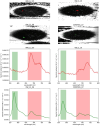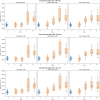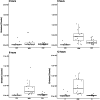Environmental challenge trials induce a biofluorescent response in the green sea urchin Strongylocentrotus droebachiensis
- PMID: 39496746
- PMCID: PMC11535239
- DOI: 10.1038/s41598-024-77648-4
Environmental challenge trials induce a biofluorescent response in the green sea urchin Strongylocentrotus droebachiensis
Abstract
Stress in sea urchins leads to high mortality and economic losses in both the environment and aquaculture. The green sea urchin Strongylocentrotus droebachiensis has been documented emitting complex biofluorescence, yet how this responds to external stressors is unknown. Adult sea urchins (n = 210) were divided between control (n = 30) and experimental groups (n = 180), using three transport variables: out of water, in water at elevated temperatures, (warm-water) and in water at seawater temperature (cold-water). Hyperspectral imaging of external fluorescence and fluorospectrometric analysis on coelomic fluid was measured at five intervals (hour 0,3,6,9,12). External green emissions (∼580 nm) responded to all treatments, peaking at h9. External red emissions (∼680-730 nm) in the cold-water remained low until an h9 peak. The warm water increased emissions at each interval, peaking at h9. The out of water gradually increased, with the highest at h12. The coelomic fluid fluorescence (∼680 nm) was low to nonexistent except in warm-water, whose elevated levels suggest that fluorescent emissions are a measurable byproduct of internal adaptation(s) to stress. Early detection of fluorescent emissions (broken spines, lesions) may prevent economic losses. The observed link between fluorescence and the applied stressors provides a baseline for developing non-invasive technology for improving echinoderm welfare.
© 2024. The Author(s).
Conflict of interest statement
The authors declare no competing interests.
Figures








Similar articles
-
Hidden in plain sight: hyperspectral documentation of complex biofluorescence produced by the green sea urchin (Strongylocentrotus droebachiensis).Methods Appl Fluoresc. 2024 Feb 7;12(2). doi: 10.1088/2050-6120/ad232e. Methods Appl Fluoresc. 2024. PMID: 38277704
-
Resource allocation and extracellular acid-base status in the sea urchin Strongylocentrotus droebachiensis in response to CO₂ induced seawater acidification.Aquat Toxicol. 2012 Apr;110-111:194-207. doi: 10.1016/j.aquatox.2011.12.020. Epub 2012 Jan 21. Aquat Toxicol. 2012. PMID: 22343465
-
Carryover effects of long-term high water temperatures on fitness-related traits of the offspring of the sea urchin Strongylocentrotus intermedius.Mar Environ Res. 2021 Jul;169:105371. doi: 10.1016/j.marenvres.2021.105371. Epub 2021 May 20. Mar Environ Res. 2021. PMID: 34044285
-
Sulfated fucans from the egg jellies of the closely related sea urchins Strongylocentrotus droebachiensis and Strongylocentrotus pallidus ensure species-specific fertilization.J Biol Chem. 2002 Jan 4;277(1):379-87. doi: 10.1074/jbc.M108496200. Epub 2001 Oct 30. J Biol Chem. 2002. PMID: 11687579
-
Effects of seawater acidification on gene expression: resolving broader-scale trends in sea urchins.Biol Bull. 2014 Jun;226(3):237-54. doi: 10.1086/BBLv226n3p237. Biol Bull. 2014. PMID: 25070868 Review.
References
-
- Shannon, R. & Mustafa, A. A. Comparison of Stress Susceptibility of Sea Urchins and Sea cucumbers in aquaculture conditions. Bioeng. Bioscience. 3, 100–107 (2015).
-
- James, P. & Evensen, T. Live transport of the green sea urchin (Strongylocentrotus droebachiensis) in air and immersed in seawater and the impact on subsequent roe enhancement after in-water transport. Aquac Res.53, 5205–5213 (2022).
-
- Wang, F., Yang, H., Gao, F. & Liu, G. Effects of acute temperature or salinity stress on the immune response in sea cucumber, Apostichopus japonicus. Comp. Biochem. Physiol. Mol. Integr. Physiol.151, 491–498 (2008). - PubMed
-
- Chi, X. et al. Transmission of black mouth disease shed light on the aquaculture management of the sea urchin Strongylocentrotus Intermedius. Aquaculture. 549, 737788 (2022).
MeSH terms
LinkOut - more resources
Full Text Sources

